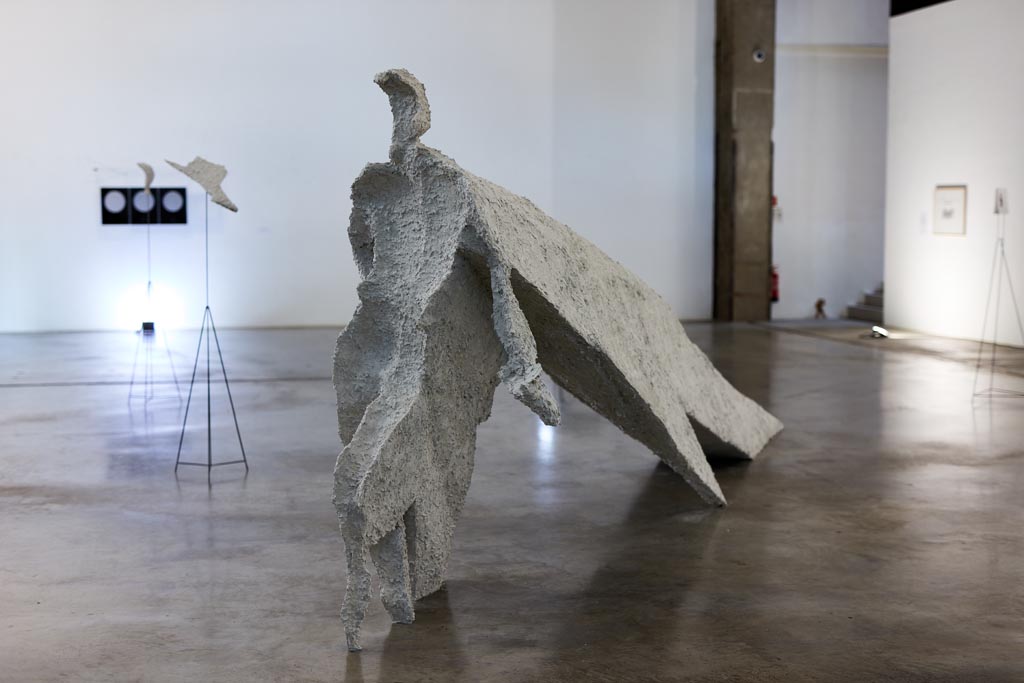Kisterem
Mátyás Fusz
„My father was not a glassmaker examines how we perceive the world, each other, and the objects in it. I strive to depict as accurately as possible the gray zones of perception and space that subconsciously affect our daily lives. I deal with small details, such as the sparsely perceptible details of space that hide from us in our own bodies, in the bodies of others, or in the world. When we do not go around an object completely and examine it from all sides, there remains a fragment of space associated with the object, which remains hidden from us. The sculptures in this case deal with human figures, bodies, and body parts, in natural situations such as a frontal conversation, a parallel figure, or parts of our own bodies that obscure a part of the world from us no matter how hard we try to turn our heads behind it. An example is the small gray zone that appears at the end of your index finger during a simple gesture of pointing. The sculptures record the position of the observer from which this space is calculated in a manner similar to the rules of perspective. On the other hand, as long as the perspective represents the point of view of a lone eyeball fixed at a fixed point, my method uses a more natural point of view. It allows the point of view to move more widely within the boundaries typical of each everyday situation. For example, in the case of a frontal conversation, I calculated the possible limits and directions of the movement of a stationary observer. The sculptures materialize a space that is never visible from this contemplative situation.“ Mátyás Fusz
Biography
Mátyás Fusz was born in 1986, he lives in Verőce and works in Budapest. He studied at the painting department of the University of Pécs and then went on to study at the Doctoral School of the Hungarian University of Fine Art. During his university years, he started taking part in group exhibitions around Hungary in Pécs, Paks, Budapest, as well as in India, Germany, and the UK. His solo shows were held in Liget Gallery and Art Gallery of Paks, among others. His artistic practice is unique in that he is primarily occupied with defining a method or system, following which the artworks can be created. This conceptual process is focused on the recording of human perception, observation and memory, followed by the systematization and visualization of these recordings.
Kisterem
Since its foundation in 2006, Kisterem represents both young artists at the beginning of their careers and established artists who often use different media to create their artworks, exceeding the comfort zone of commercial contemporary art galleries. Through its exhibitions and events, the gallery aims to facilitate encounters between artists, representatives of institutions, curators, and collectors, as well as visitors keen on contemporary art. Kisterem is committed to the representation of Hungarian art abroad, it participates regularly in prominent international art fairs and cooperates in unique projects. As a result of these, following the gallery’s exhibitions, several works of artists represented by Kisterem have been acquired by major museums.

Margit Valkó
0036309601015
Mátyás Fusz
„My father was not a glassmaker examines how we perceive the world, each other, and the objects in it. I strive to depict as accurately as possible the gray zones of perception and space that subconsciously affect our daily lives. I deal with small details, such as the sparsely perceptible details of space that hide from us in our own bodies, in the bodies of others, or in the world. When we do not go around an object completely and examine it from all sides, there remains a fragment of space associated with the object, which remains hidden from us. The sculptures in this case deal with human figures, bodies, and body parts, in natural situations such as a frontal conversation, a parallel figure, or parts of our own bodies that obscure a part of the world from us no matter how hard we try to turn our heads behind it. An example is the small gray zone that appears at the end of your index finger during a simple gesture of pointing. The sculptures record the position of the observer from which this space is calculated in a manner similar to the rules of perspective. On the other hand, as long as the perspective represents the point of view of a lone eyeball fixed at a fixed point, my method uses a more natural point of view. It allows the point of view to move more widely within the boundaries typical of each everyday situation. For example, in the case of a frontal conversation, I calculated the possible limits and directions of the movement of a stationary observer. The sculptures materialize a space that is never visible from this contemplative situation.“ Mátyás Fusz
Biography
Mátyás Fusz was born in 1986, he lives in Verőce and works in Budapest. He studied at the painting department of the University of Pécs and then went on to study at the Doctoral School of the Hungarian University of Fine Art. During his university years, he started taking part in group exhibitions around Hungary in Pécs, Paks, Budapest, as well as in India, Germany, and the UK. His solo shows were held in Liget Gallery and Art Gallery of Paks, among others. His artistic practice is unique in that he is primarily occupied with defining a method or system, following which the artworks can be created. This conceptual process is focused on the recording of human perception, observation and memory, followed by the systematization and visualization of these recordings.
Kisterem
Since its foundation in 2006, Kisterem represents both young artists at the beginning of their careers and established artists who often use different media to create their artworks, exceeding the comfort zone of commercial contemporary art galleries. Through its exhibitions and events, the gallery aims to facilitate encounters between artists, representatives of institutions, curators, and collectors, as well as visitors keen on contemporary art. Kisterem is committed to the representation of Hungarian art abroad, it participates regularly in prominent international art fairs and cooperates in unique projects. As a result of these, following the gallery’s exhibitions, several works of artists represented by Kisterem have been acquired by major museums.

